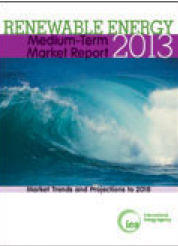
Despite a difficult economic context, renewable power is expected to increase by 40% in the next five years. The share of non-hydro sources such as wind, solar, bioenergy and geothermal in total power generation will double, reaching 8% by 2018, up from 4% in 2011 and just 2% in 2006.
In statements at the Renewable Energy Finance Forum in New York last week, IEA Executive Director Maria van der Hoeven warned that “policy uncertainty is public enemy number one” for investors: “Many renewables no longer require high economic incentives. But they do still need long-term policies that provide a predictable and reliable market and regulatory framework compatible with societal goals,” she stated. “And worldwide subsidies for fossil fuels remain six times higher than economic incentives for renewables.”
The report shows that renewables are becoming cost-competitive in a wider set of circumstances. For example, wind competes well with new fossil-fuel power plants in several markets, including Brazil, Turkey and New Zealand. Solar is attractive in markets with high peak prices for electricity, for instance, those resulting from oil-fired generation. Decentralised solar photovoltaic generation costs can be lower than retail electricity prices in a number of countries.

 RSS Feed
RSS Feed